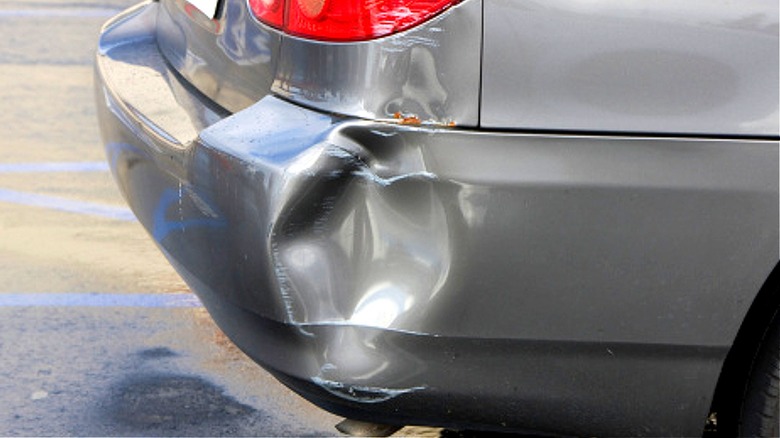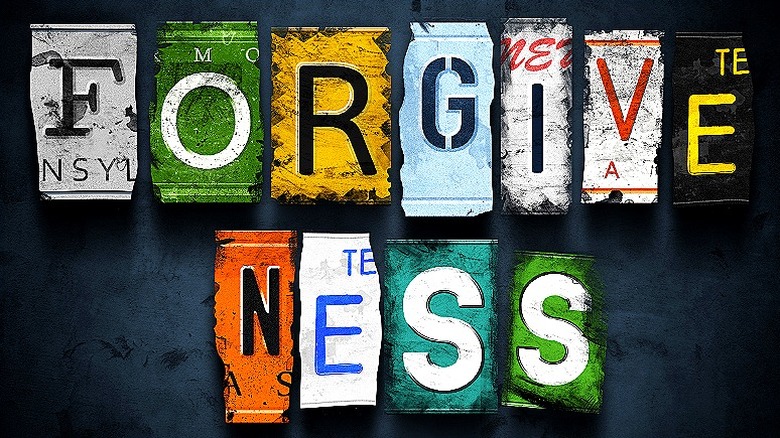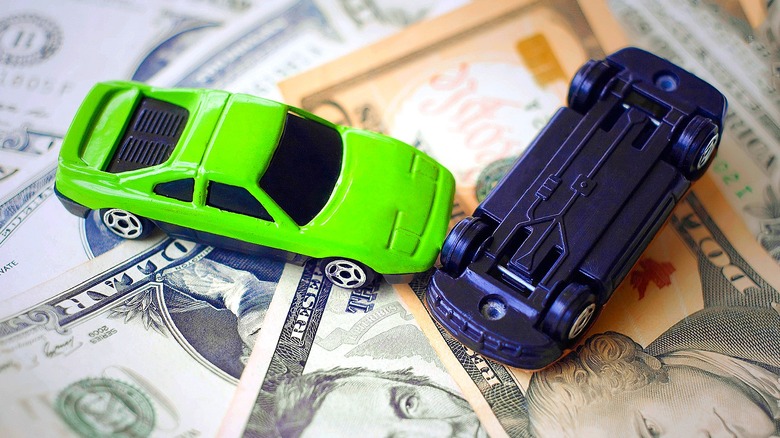Accident Forgiveness Coverage Isn't Always Worth It. Here's Why
One of the first concerns that drivers have following a fender-bender — besides making sure that nobody is hurt — is that their car insurance is going to get a whole lot more expensive. According to analysis by Forbes, the rate of increase for at-fault drivers in an accident with property damage is 38%. If someone is injured, that rate increase jumps to 40%. Of course, this is all in addition to the nearly 20% year-over-year inflation in car insurance rates for 2023 — even for drivers with zero tickets or accidents during that period.
With accident forgiveness, insurance companies promise that they won't hike your rate following your first at-fault accident — known in the industry as a chargeable accident. Some insurers offer accident forgiveness for free to longstanding customers with spotless driving records, while other companies offer it as an extra-cost option on their policies. Note that even if you're willing to pay for the accident forgiveness add-on, a clean driving record for the past three to five years is required to be eligible. All that considered, is it worth paying a small extra amount per month for accident forgiveness or are you better off taking your chances?
What's a chargeable accident?
It sounds like a scary term, a chargeable accident is simply one in which you were found to be at found; usually one in which you were more than 50% to blame. A chargeable accident can be as minimal as a low-speed parking lot fender bender or as severe as a crash where someone is injured or even dies. In certain states, such as Massachusetts, Minnesota, and New York, the criteria for a chargeable accident also involves exceeding a certain dollar amount of damages, which varies between $500 to $2,000.
In any case, when insurance companies are notified that you were at fault in an accident, they will apply a surcharge to your car insurance premiums, hence the name chargeable. This said, if you have accident forgiveness coverage on your policy, you'll be forgiven for your first such accident, though the accident will remain on your driving record (and insurers can typically access the seven most recent years).
Also, note not every type of accident will result in a surcharge. For example, accidents where the other driver was clearly at fault and received the moving violation. Other non-chargeable accidents include those involving striking an animal, an accident caused by defective tires, and hit-and-run scenarios, to name a few.
How accident forgiveness works
Just because you have accident forgiveness coverage on your policy, that doesn't mean your car insurance rates won't increase as a result of a chargeable accident. Unfortunately, it's not that simple. Sure, you won't be assessed a premium increase based on that accident, but you may lose a good driver discount or similar savings for not having made a claim in recent years. That said, the price increase from losing a discount will almost surely be less than a rate hike based on the accident.
For example, let's assume a pre-accident annual policy premium of $1,000. If you were receiving a 5% safe driver discount, the effective payment would be $950 per year. After having a chargeable accident, you'll likely lose the safe driver discount and return to paying $1,000, but that's better than a 40% hike as a result of the accident, which would total $1,400 a year and likely last several years. Note, most car accidents stay on your driving record for three to five years, depending on your state (and some accidents can stay on for longer).
Further, to enjoy the accident forgiveness rate, you'll need to stick with the company you're with. Switching to another insurer will result in the new company scrutinizing your driving record and seeing the accident (remember, companies can access the last seven years). Also keep in mind that accident forgiveness isn't a "get out of jail free" card. Typical policies permit just one incident of accident forgiveness per policy, even if it's a family policy with multiple drivers.
How much can you really save?
In the previous section, we gave an example using a policy that originally cost $1,000 per year to keep the math simple. In real life, your insurance isn't likely to be that cheap. According to Bankrate, the average price for full coverage insurance is $2,014 per year. Therefore, a 35% to 40% hike that lasts a duration of three to five years could easily amount to $2,000 to $4,000 extra.
Now, let's look at how much accident forgiveness coverage costs. Some sources state that accident forgiveness is a bargain at an extra $15 to $60 a year while others say that the add-on costs more like 2% to 9% additional. Taking our $2,014 per year average premium into consideration, that equates to a range of $15 to approximately $180 per year extra for accident forgiveness, assuming that your insurer isn't one that gifts it for free to longstanding (and safe driver) customers.
Is the add-on worth considering?
It's definitely worth considering adding accident forgiveness coverage to your insurance policy, assuming your history with the insurer and driving record qualify you to do so. Exactly how much you could save really depends on how long you've been paying for accident forgiveness without getting in a chargeable accident.
Obviously, if you've only been paying into the program a few months and you have an at-fault accident, accident forgiveness will be the deal of the century. On the other hand, if you've been paying for accident forgiveness for 10 years before an incident occurs, the value won't be as great. Finally, some experts maintain that accident forgiveness is never truly free. Even if an insurance company doesn't openly charge for the extra coverage, the cost is likely baked into higher rates overall.
For another way to save besides accident forgiveness coverage, drivers might research companies that offer "vanishing deductibles." A deductible is the out-of-pocket costs you pay before insurance covers the rest. For example, a driver with a $1,000 deductible would have to pay $1,000 of a $3,000 at-fault accident repair bill, while the insurance company pays $2,000 toward the repair. A driver with a $500 deductible? The split would be $500/$2500. With a vanishing deductible, the company lowers the deductible over time. Travelers Insurance, for example, lowers the deductible on certain policies by $50 for every six months that a customer doesn't make a claim, capped at a maximum benefit of $500.




